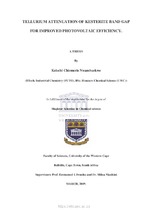Tellurium attenuation of kesterite band-gap for improved photovoltaic efficiency
Abstract
Tellurium is a member of the chalcogen group in the periodic table and is known to be a better semiconductor material when compared to sulfur and selenium. By introducing tellurium into the kesterite structure there would be an improvement in the semiconducting property of the kesterite material. This research focused on incorporating tellurium into kesterite structure in order to reduce its band-gap thereby improving its light absorption and ultimately lead to a more efficient photovoltaic effect. For a typical synthesis, kesterite nanoparticles were synthesized by anion hot injection process which involved the injection of the anion precursor comprising of sulfur, selenium and tellurium in diethylene glycol into a solution containing the cation precursor which are copper (II) chloride, Zinc chloride and tin (II) chloride which are dissolved in diethylene glycol. The synthesized nanoparticles were copper zinc tin sulfide (CZTS), copper zinc tin sulfide selenide telluride (CZTSSeTe) and copper zinc tin sulfide telluride (CZTSTe). Morphological characterization of the synthesized nanoparticles was carried out by high-resolution scanning electron microscopy (HRSEM) and high-resolution transmission electron microscopy (HRTEM) to obtain the shape of the surface and internal structure of the nanoparticles respectively. The micrograph obtained from HRSEM shows that all synthesized nanoparticles had a flower-like surface appearance which is a common morphology obtained for non-vacuum synthesized kesterite nanoparticles. The micrograph obtained from TEM showed that all nanoparticles were agglomerated and had a black surface covering which attributable to the solvent used during synthesis, washing and centrifugation. The internal structure of the synthesized nanoparticles was obtained through small angle x-ray scattering (SAXS) plot of the shapes. The shape obtained for the nanoparticles were core shell hollow sphere for CZTS, core shell dumb-bell for CZTSSeTe and solid sphere for CZTSTe.

